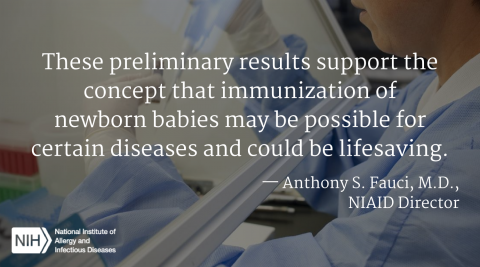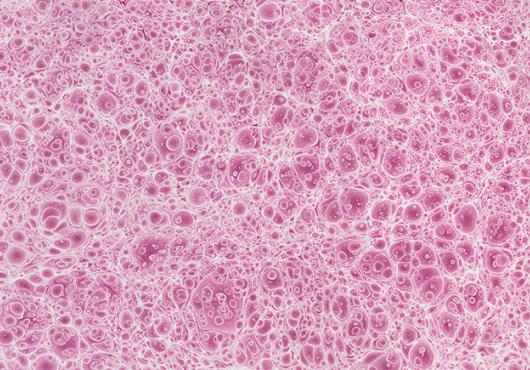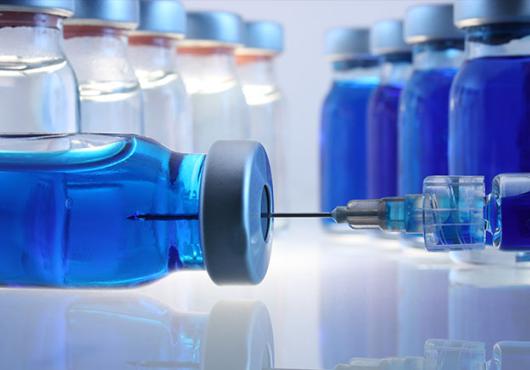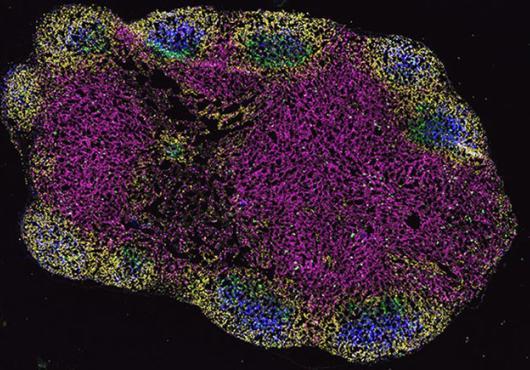
In many parts of the world, babies have just one chance to be vaccinated: when they’re born. Unfortunately, newborns’ immune systems don’t respond well to most vaccines. That’s why, in the U.S., most immunizations start at two months of age.
Currently, only BCG (for tuberculosis), polio and hepatitis B vaccines work in newborns, and the last two require multiple doses. But new research raises the possibility of one-shot vaccinations at birth—with huge implications for reducing infant mortality.
The trick? Specially designed additives—adjuvants—tailored to stimulate newborns’ unique immune systems.
Two papers published today demonstrate strong vaccine responses in newborn mice, and, more importantly, in newborn monkeys, the ultimate preclinical test. Both studies used formulations designed to maximize safety.
“Our efforts have led to adjuvant approaches that may enable earlier protection of newborns and young infants from life-threatening infectious diseases, such as pneumococcus, pertussis or even respiratory syncytial virus,” said Ofer Levy, HMS associate professor of pediatrics at Boston Children’s Hospital and a senior author of both papers.
Dramatic response
The first of the new studies, led by David Dowling, an HMS research fellow in pediatrics in the Division of Infectious Diseases at Boston Children’s, tested an adjuvant called 3M-052. The adjuvant was manufactured by 3M Drug Delivery Systems, which partially funded the study. It works by stimulating two specific toll-like receptors (pathogen-sensing proteins), TLR7 and TLR8.
Newborn rhesus monkeys received a series of three shots with the existing Prevnar 13 pneumococcal vaccine—“the same as my children got,” said Levy, who directs the Precision Vaccines Program at Boston Children’s.
The team chose pneumococcal vaccine as a test case because Streptococcus pnumoniae can cause potentially fatal pneumonia, meningitis and sepsis in infants.
Prevnar 13 already comes with an adjuvant, Alum, but half the monkeys were randomized to also receive 3M-052. All were monitored at the Tulane National Primate Research Center.
As reported in JCI Insight, the immune response was dramatic.
At day 28, even before their second dose, the monkeys receiving 3M-052 were producing robust quantities of antibodies. In fact, their antibody levels were 10 to 100 times higher than those with Prevnar 13 alone—high enough to ensure protection against infection. They also showed dramatically enhanced production of CD4+ T cells and B cells specific to Streptococcus pneumoniae.

“The protective antibody response we saw was so strong that it’s conceivable that you could get protection with one shot,” said Levy. “This is critical because in many parts of the world, birth is the most reliable point of healthcare contact. After birth, it becomes challenging to bring children in for repeated clinic visits.”
The 3M-052 adjuvant was chemically modified to minimize side effects. An added lipid “tail,” which doesn’t mix well with water, keeps the adjuvant from getting into the bloodstream, where it could cause side effects.
“Rather than floating all over the place causing fever and chills, it stays put in the muscle and enhances the immune response to the vaccine,” said Levy.
Alternate approach
The second study, published in the Journal of Allergy and Clinical Immunology, was led by Dowling and Evan Scott of Northwestern University. It tested a different adjuvant, CL075, and a different type of formulation.
This time, vaccine and adjuvant were encapsulated in nanoparticles designed to maximize the immune response while avoiding side effects. Specifically, the particles were engineered to be taken up by antigen-presenting cells, which instruct lymphocytes to make antibodies.
When the team added the particles to human cells in a dish or injected them into mice expressing the human TLR8 gene, immune responses were as good as or better than those induced by the BCG vaccine (one of the few vaccines that works in newborns).
Next steps
The team now plans to develop highly stable vaccine formulations, obtain more safety data and further characterize responses in newborns versus older infants.
Levy intends to work with collaborators from around the world, via the Precision Vaccines Program, to work towards launching human trials.
“There’s not a long list of vaccines that can be given at birth, and we need better vaccine formulations against a range of early-life infectious pathogens,” said Levy. “We hope to meet these challenges.”
Jeffrey Hubbell of École Polytechnique Fédérale de Lausanne in Switzerland, now at the University of Chicago, was co-senior author on the second paper with Levy.
The research was funded by the Bill & Melinda Gates Foundation, the National Institutes of Health/NIAID, the European Research Council and Boston Children’s Hospital. The Levy Laboratory also received sponsored research support from 3M Drug Delivery Systems.
Adapted from a post on Vector, the Boston Children’s science and clinical innovation blog.





